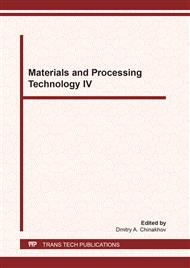p.1
p.8
p.15
p.22
p.31
p.41
p.50
p.59
Influence of Laser Power and Scanning Speed on the Formation of Single Tracks Formed by Laser Cladding
Abstract:
One of the well-known methods for increasing wear resistance, especially for friction pairs, is surfacing wear-resistant materials on the working surfaces of mating parts [1, 2, 3]. Less expensive grades of steel can be used as the main material in the manufacture of parts, and the surfacing materials in this case must have increased characteristics: mechanical, corrosion and radiation resistance, heat resistance, wear resistance; good anti-friction properties, i.e. more expensive [4, 5]. This significantly reduces the cost of manufacturing or repairing parts, especially in mass production, since cheap grades of steel are used for their manufacture [5, 6]. Improvement of parts by gas powder laser cladding is carried out in shipbuilding, energy, oil and gas and mining industries, in the aviation industry and others. Note that although the method of coating appeared a long time ago, various methods of applying surfaced coatings are still being developed and refined [5,6]. In gas powder laser cladding, coatings are obtained by forcing the powder flow directly into the laser radiation zone [7, 8]. The powder particles are heated in the laser radiation zone and fall on the treated surface (substrate). It is known that the powder particles melt only after they hit the substrate [3, 4], but at the same time the surface layer of the base metal melts. After heating and melting the substrate, a liquid melt bath is formed, which, along with the molten powder, contains a significant part of the base metal components [7, 8]. The intensity of saturation of the surfacing metal with the substrate components is characterized by the proportion of the base metal in the cross section of the track, which is determined by the mixing ratio [9, 10, 11]. It is equal to the ratio of the area of the melted substrate to the sum of the areas of the melted substrate and the track as a percentage and depends on the cladding modes, which is determined after metallographic studies of the structure of protective coatings [8].
Info:
Periodical:
Pages:
15-21
Citation:
Online since:
January 2021
Authors:
Price:
Сopyright:
© 2021 Trans Tech Publications Ltd. All Rights Reserved
Share:
Citation:


